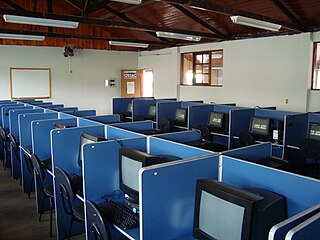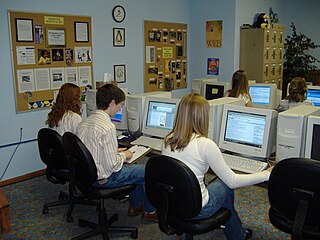Distance education, also known as distance learning, is the education of students who may not always be physically present at school, or where the learner and the teacher are separated in both time and distance. Traditionally, this usually involved correspondence courses wherein the student corresponded with the school via mail. Distance education is a technology-mediated modality and has evolved with the evolution of technologies such as video conferencing, TV, and the Internet. Today, it usually involves online education and the learning is usually mediated by some form of technology. A distance learning program can either be completely a remote learning, or a combination of both online learning and traditional offline classroom instruction. Other modalities include distance learning with complementary virtual environment or teaching in virtual environment (e-learning).

Collaboration is the process of two or more people, entities or organizations working together to complete a task or achieve a goal. Collaboration is similar to cooperation. Most collaboration requires leadership, although the form of leadership can be social within a decentralized and egalitarian group. Teams that work collaboratively often access greater resources, recognition and rewards when facing competition for finite resources.
Situated learning is a theory that explains an individual's acquisition of professional skills and includes research on apprenticeship into how legitimate peripheral participation leads to membership in a community of practice. Situated learning "takes as its focus the relationship between learning and the social situation in which it occurs".
Blended learning or hybrid learning, also known as technology-mediated instruction, web-enhanced instruction, or mixed-mode instruction, is an approach to education that combines online educational materials and opportunities for interaction online with physical place-based classroom methods.

Asynchronous learning is a general term used to describe forms of education, instruction, and learning that do not occur in the same place or at the same time. It uses resources that facilitate information sharing outside the constraints of time and place among a network of people. In many instances, well-constructed asynchronous learning is based on constructivist theory, a student-centered approach that emphasizes the importance of peer-to-peer interactions. This approach combines self-study with asynchronous interactions to promote learning, and it can be used to facilitate learning in traditional on-campus education, distance education, and continuing education. This combined network of learners and the electronic network in which they communicate are referred to as an asynchronous learning network.

An online school teaches students entirely or primarily online or through the Internet. It has been defined as "education that uses one or more technologies to deliver instruction to students who are separated from the instructor and to support regular and substantive interaction between the students. Online education exists all around the world and is used for all levels of education. This type of learning enables the individuals to earn transferable credits, take recognized examinations, and advance to the next level of education over the Internet.
Educational technology is the combined use of computer hardware, software, and educational theory and practice to facilitate learning. When referred to with its abbreviation, "EdTech," it often refers to the industry of companies that create educational technology. In EdTech Inc.: Selling, Automating and Globalizing Higher Education in the Digital Age, Tanner Mirrlees and Shahid Alvi (2019) argue "EdTech is no exception to industry ownership and market rules" and "define the EdTech industries as all the privately owned companies currently involved in the financing, production and distribution of commercial hardware, software, cultural goods, services and platforms for the educational market with the goal of turning a profit. Many of these companies are US-based and rapidly expanding into educational markets across North America, and increasingly growing all over the world."
Technology integration is defined as the use of technology to enhance and support the educational environment. Technology integration in the classroom can also support classroom instruction by creating opportunities for students to complete assignments on the computer rather than with normal pencil and paper. In a larger sense, technology integration can also refer to the use of an integration platform and application programming interface (API) in the management of a school, to integrate disparate SaaS applications, databases, and programs used by an educational institution so that their data can be shared in real-time across all systems on campus, thus supporting students' education by improving data quality and access for faculty and staff.
"Curriculum integration with the use of technology involves the infusion of technology as a tool to enhance the learning in a content area or multidisciplinary setting... Effective technology integration is achieved when students can select technology tools to help them obtain information on time, analyze and synthesize it, and present it professionally to an authentic audience. Technology should become an integral part of how the classroom functions—as accessible as all other classroom tools. The focus in each lesson or unit is the curriculum outcome, not the technology."
Computer-supported collaborative learning (CSCL) is a pedagogical approach wherein learning takes place via social interaction using a computer or through the Internet. This kind of learning is characterized by the sharing and construction of knowledge among participants using technology as their primary means of communication or as a common resource. CSCL can be implemented in online and classroom learning environments and can take place synchronously or asynchronously.
Synchronous learning refers to a learning event in which a group of students are engaging in learning at the same time. Before learning technology allowed for synchronous learning environments, most online education took place through asynchronous learning methods. Since synchronous tools that can be used for education have become available, many people are turning to them as a way to help decrease the challenges associated with transactional distance that occurs in online education. Several case studies that found that students are able to develop a sense of community over online synchronous communication platforms.
An edublog is a blog created for educational purposes. Edublogs archive and support student and teacher learning by facilitating reflection, questioning by self and others, collaboration and by providing contexts for engaging in higher-order thinking. Edublogs proliferated when blogging architecture became more simplified and teachers perceived the instructional potential of blogs as an online resource. The use of blogs has become popular in education institutions including public schools and colleges. Blogs can be useful tools for sharing information and tips among co-workers, providing information for students, or keeping in contact with parents. Common examples include blogs written by or for teachers, blogs maintained for the purpose of classroom instruction, or blogs written about educational policy. Educators who blog are sometimes called edubloggers.
A Knowledge Building Community (KBC) is a community in which the primary goal is knowledge creation rather than the construction of specific products or the completion of tasks. This notion is fundamental in Knowledge building theory. If knowledge is not realized for a community then we do not have knowledge building. Examples of KBCs are
Synchronous conferencing or synchronous computer-mediated communication is the formal term used in computing, in particular in computer-mediated communication, collaboration, and learning, to describe technologies informally known as online chat. It is sometimes extended to include audio/video conferencing or instant messaging systems that provide a text-based multi-user chat function. The word synchronous is used to qualify the conferencing as real-time, as distinct from a system such as e-mail, where messages are left and answered later.
Online tutoring is the process of tutoring in an online, virtual, or networked, environment, in which teachers and learners participate from separate physical locations. Aside from space, participants can also be separated by time.

Computers in the classroom include any digital technology used to enhance, supplement, or replace a traditional educational curriculum with computer science education. As computers have become more accessible, inexpensive, and powerful, the demand for this technology has increased, leading to more frequent use of computer resources within classes, and a decrease in the student-to-computer ratio within schools.
Online communication between home and school is the use of digital telecommunication to convey information and ideas between teachers, students, parents, and school administrators. As the use of e-mail and the internet becomes even more widespread, these tools become more valuable and useful in education for the purposes of increasing learning for students, and facilitating conversations between students, parents, and schools.

Global SchoolNet (GSN) is a nonprofit 501(c)(3) international educational organization that serves as a clearinghouse for collaborative educational projects, many that are based on the Constructivist Learning model. The organization coordinates projects and competitions focused on humanitarian issues, diplomacy, leadership, innovative teaching, entrepreneurship, STEM, and other academics for schools and youth organizations internationally. About 150,000 educators from 194 countries have registered as members of Global SchoolNet, and about 5.5 million students from 109 countries have participated in GSN projects as of 2020. Global SchoolNet is known for two international competitions, the International CyberFair for students in grades kindergarten through high school, and the U.S. State Department-sponsored Doors to Diplomacy for ages 12 through 19. Global SchoolNet was established in 1984 as Free Educational Mail (FrEdMail) in San Diego, California, where its headquarters still exists.

Dr. Yvonne Marie Andrés is an American educator who is recognized as an e-learning pioneer and visionary. Andrés is the co-founder of the non-profit Global SchoolNet (1984) and the founder of the Global Schoolhouse (1992). Andrés was named one of the 25 most influential people worldwide in education technology and was invited to meet with President Bush to launch the Friendship Through Education initiative (2000). Andrés is the creator and producer of International CyberFair and the US State Department’s Doors to Diplomacy program. Andrés frequently writes about highly effective education programs from around the globe that blend online and offline learning, while incorporating the latest neuroplasticity findings and Constructivist Learning methodology. Andrés has provided leadership throughout the US, Canada, Asia, Europe, Australia, South America and Africa and in 2007 Andrés was awarded the Soroptimist International Making a Difference Award for advancing the status of women and children. Andrés was selected as one of San Diego Magazine's Women Who Move the City, recognizing dynamic women who create positive change and contribute to the community. In 2021 Andrés was recognized as One of the Most Influential Women in Technology by San Diego Business Journal.

Online learning involves courses offered by primary institutions that are 100% virtual. Online learning, or virtual classes offered over the internet, is contrasted with traditional courses taken in a brick-and-mortar school building. It is a development in distance education that expanded in the 1990s with the spread of the commercial Internet and the World Wide Web. The learner experience is typically asynchronous but may also incorporate synchronous elements. The vast majority of institutions utilize a learning management system for the administration of online courses. As theories of distance education evolve, digital technologies to support learning and pedagogy continue to transform as well.
Virtual exchange is an instructional approach or practice for language learning. It broadly refers to the "notion of 'connecting' language learners in pedagogically structured interaction and collaboration" through computer-mediated communication for the purpose of improving their language skills, intercultural communicative competence, and digital literacies. Although it proliferated with the advance of the internet and Web 2.0 technologies in the 1990s, its roots can be traced to learning networks pioneered by Célestin Freinet in 1920s and, according to Dooly, even earlier in Jardine's work with collaborative writing at the University of Glasgow at the end of the 17th to the early 18th century.






